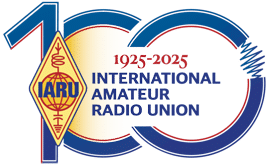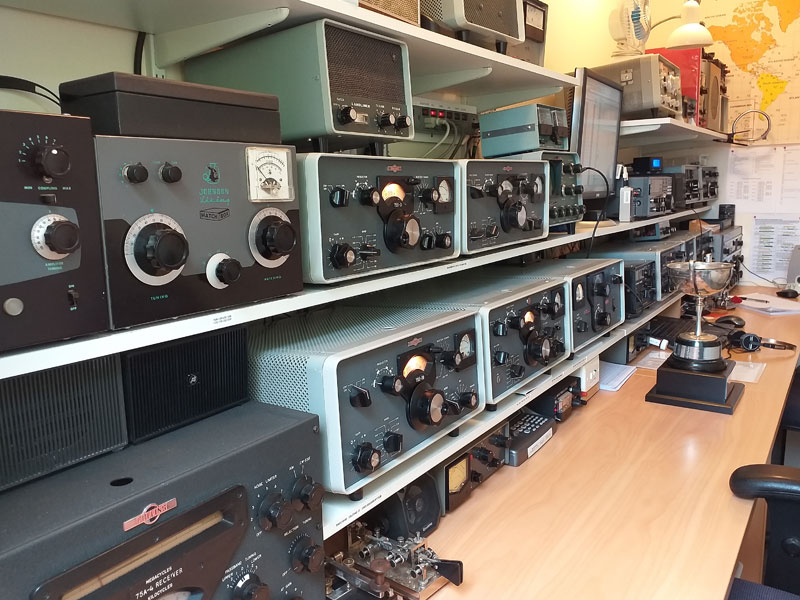
Amateur radio station ZL1NZ is located in south-central Auckland, New Zealand, overlooking the Manukau Harbour.
It is a vintage ham radio station (some people call it a radio museum!) designed for long-distance communication on the shortwave bands.
There are four main setups in the shack, plus lots of other gear:
Station 1: Classic CW (1950s)
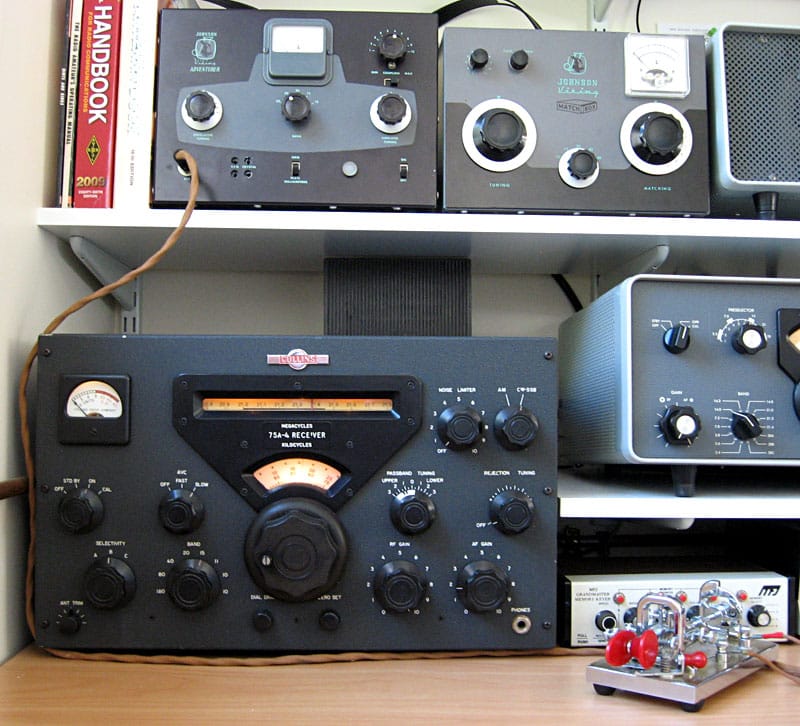
Johnson Adventurer transmitter, Matchbox antenna coupler, Collins 75A-4 receiver
This station consists of US-built equipment employing valves (vacuum tubes). It is used for CW (Morse code) communications.
- Johnson Viking Adventurer CW transmitter (50W input, xtal controlled)
- Collins 75A-4 receiver (1955) including all 3 mechanical filters
Station 2: Collins ‘S/Line Plus’ (late 1960s)
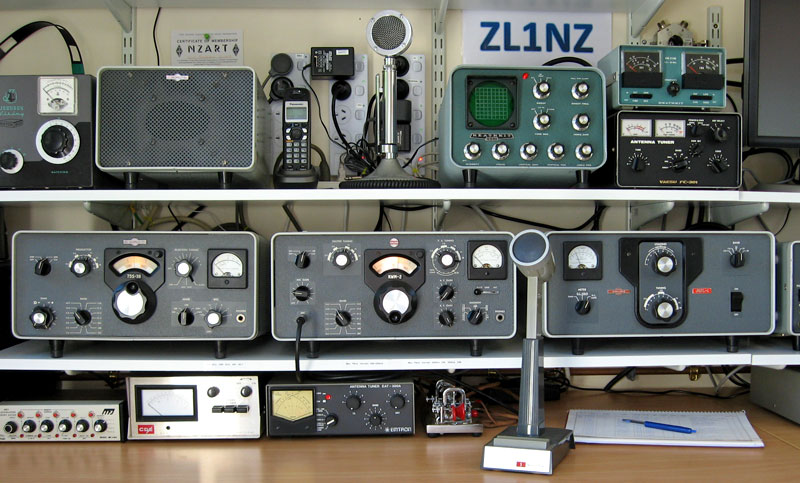
Collins S-Line L-R: 75S-3B, KWM-2, 30L-1
This station consists entirely of US-built equipment employing valves (vacuum tubes). It is used for single-sideband (voice) communications.
At the heart of this station is equipment from the prestigious Collins Radio Company of Cedar Rapids, Iowa. The heart of the station is a KWM-2 transceiver, the first commercially successful combination of amateur transmitter and receiver in a single package. The KWM-2 was introduced in 1959 and continued in production through the late 1970s.
Complementing the KWM-2 transceiver is a 75S-3B receiver. This permits not just split-frequency operation (as in a regular S/Line station with dedicated transmitter and receiver) but also the ability to listen to two frequencies simultaneously. Also the 75S-3B has some features not found on the KWM-2, e.g. rejection tuning, variable BFO, adjustable AGC and a choice of filters. So, I’ve dubbed it an “S/Line Plus”.
The 30L-1 linear amplifier uses four 811-A valves for about 500 watts output.
Other equipment in the station is by prominent US manufacturers Heathkit and Johnson.
Sadly, all of these companies have ceased producing amateur radio equipment.
- Collins 75S-3B receiver
- Collins KWM-2 100 watt SSB transceiver
- Collins 516F-2 power supply
- Collins 30L-1 kilowatt amplifier
- Johnson Viking Match Box antenna coupler
- Heathkit SB-610 monitor scope
- Heathkit HM-2140 SWR/Watt meter
- Emtron EAT-300A antenna coupler, SWR/Watt meter, balun
- Shure 444 microphone
Station 3: Yaesu FT-101 series (1970s)
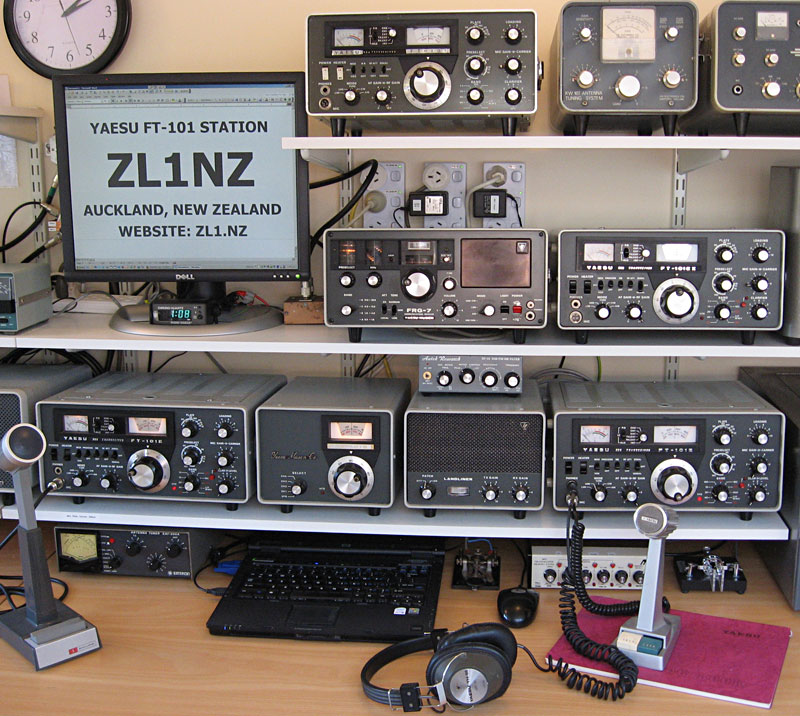
An assortment of Yaesu FT-101 series equipment at ZL1NZ. Note the Yaesu desk mic, headphones and logbook.
This station consists of Japanese-built Yaesu equipment from the mid 1970s.
The main equipment is a pair of Yaesu FT-101E transceivers – an early model that includes the 11-metre band and a later model that was made after the 11-metre band was transferred from amateur radio to citizen band radio. There is also an FT-101EX (same as the FT-101E but without an RF speech processor) as well as an original FT-101.
These are “hybrid” radios, with valves (vacuum tubes) used in the high-power stages and transistors used in other areas. Even after all these years, I still get a surprise when I switch on one of these radios and hear the receiver come to life immediately, rather than waiting 20-30 seconds for it to warm up as with the all-valve equipment. I also use an FV-101B external VFO when working DX stations operating split frequency.
Rounding out this station is an all-solid-state Yaesu FRG-7 general coverage receiver for listing to shortwave broadcasts and to amateur radio stations using the traditional AM mode of voice transmission.
- Yaesu FT-101E 100 watt CW/SSB transceiver (with 11 metres)
- Yaesu FT-101E 100 watt CW/SSB transceiver (without 11 metres)
- Yaesu FT-101EX 100 watt CW/SSB transceiver
- Yaesu FT-101 100 watt CW/SSB transceiver
- Yaesu FV-101B external VFO
- Yaesu SP-101PB speaker/phonepatch
- Emtron EAT-300A antenna coupler, SWR/Watt meter, balun
- MFJ-484 Grandmaster memory keyer
- Autek QF-1A audio filter
- JPS ANC-4 active noise canceller
- Shure 444 microphone, Yaesu microphone
Station 4: Yaesu (1981)
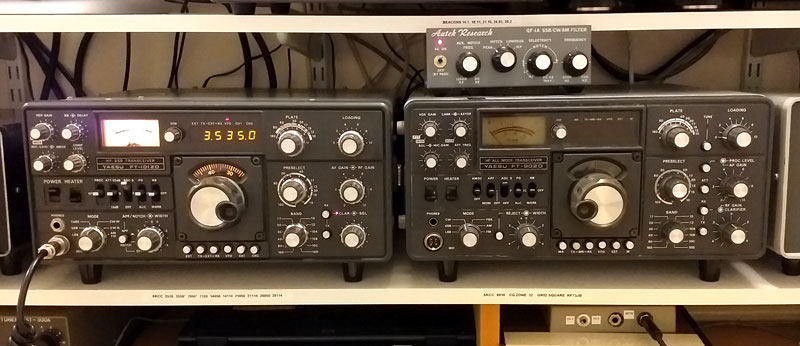
- Yaesu FT-101ZD Mk3 100 watt CW/SSB transceiver
- Yaesu FT-902D 100 watt CW/SSB transceiver, upgraded to a DM model (memory, keyer, etc.)
Receivers
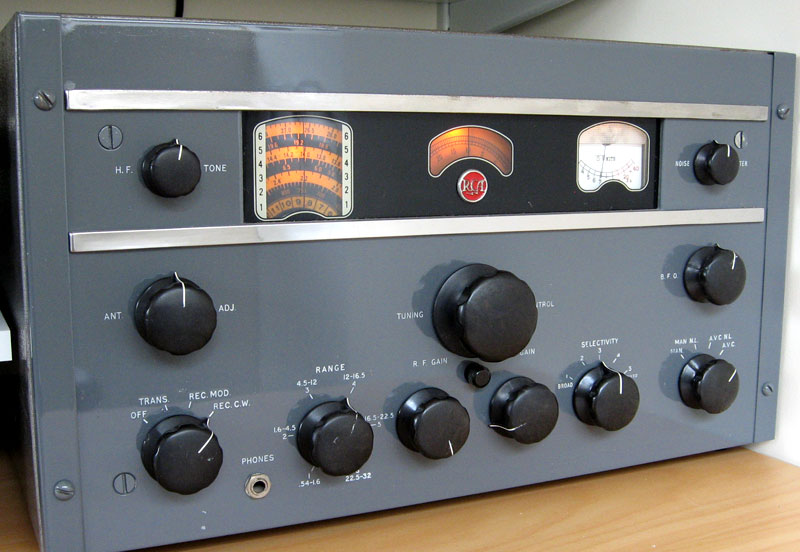
RCA AR-88D
This US-made type of receiver was widely used in Britain for signals interception during WW2. It has a home-made S Meter, which was fairly common, as meters were rarely supplied with the radio due to wartime shortages of parts.

JRC NRD-525
This all solid-state receiver from the late 1980s covers HF, MF and LF. Shown here copying ZL1ZLD in the 630m band.
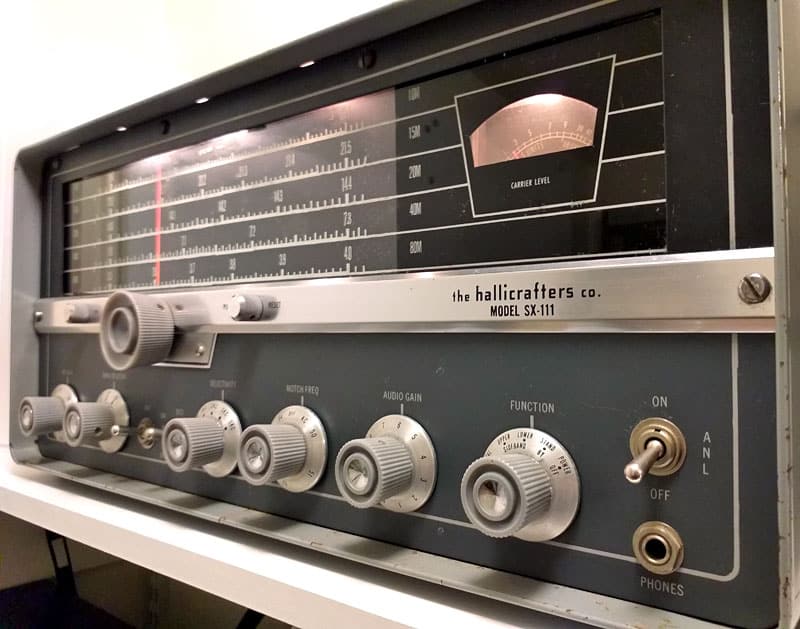
Hallicrafters SX-111
These receivers cover the ham bands (80-10m) and were made in Chicago in the early 1960s (companion to the HT37 transmitter). Mine is the earlier (non Mark 1) version, meaning it has no product detector, although it still receives SSB very well. It has also been to Antarctica!
- Sony ICF 2010 portable general coverage receiver
I purchased this new in 1986 and it was the only HF radio equipment on our yacht while crossing the Pacific in the late 1980s. It was used mostly for receiving time signals (accurate time being essential for celestial navigation) and weather reports (SSB, CW and IAC Fleet Code).
Other equipment
Antennas
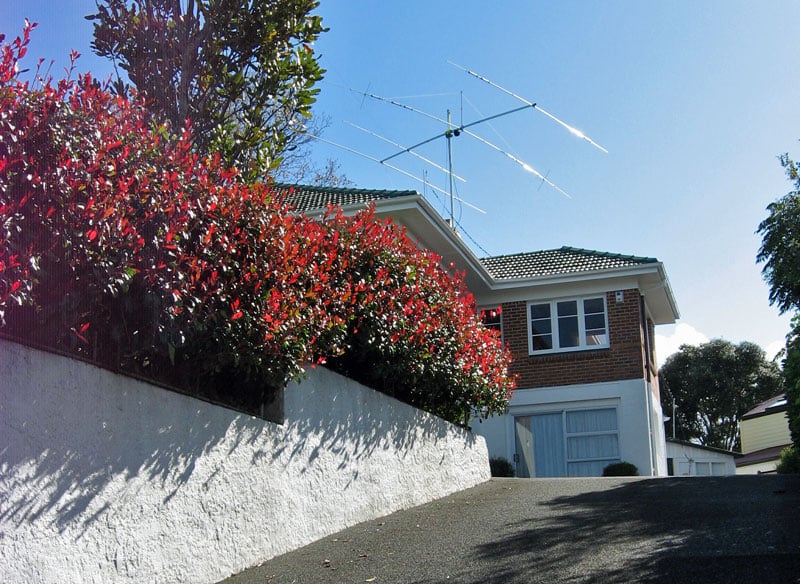
- 80m doublet, fed with 450-ohm window line, for all bands, at 6m high
- Cushcraft A4S yagi for 10, 15, 20 and 40m, at 11m high
VE3OSC tribute page: As a teenage ham, I was fortunate to become an operator at the world-class VE3OSC, operating from the Ontario Science Centre in Toronto.



